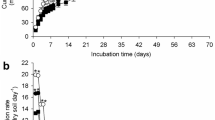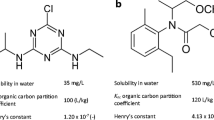Abstract
The research was carried out toascertain the effect of rimsulfuron, a solfonylureaherbicide, on soil microbial biomass growth andactivity. Laboratory experiments were performed in asilty clay loam soil to relate changes of soilmicrobial biomass-C content and global hydrolyticactivity to the rimsulfuron persistence underdifferent conditions of temperature and soil humidity.The results showed that rimsulfuron persistencedepended significantly on temperature, while itremained almost unchanged by humidity changes. A rangeof half-life values from 3.5 to 14.8 days was found ina temperature range from 10 °C to 25 °C,with lower half-lives at higher temperature.Persistence data were processed with the VARLEACHmodel, in order to predict rimsulfuron persistenceunder different environmental conditions. On comparingtreated soils with untreated soil samples, decreasesin the microbial biomass-C content and increases inthe global hydrolytic activity were found to beconnected with rimsulfuron persistence at the variousexperimental conditions. These effects persisted fora short time and, they were evident earlier at highertemperature and more persistent at lower humidity.This behaviour is discussed in terms of rimsulfurontoxicity, with the consequent release of endocellularhydrolytic enzymes from the dead microorganisms. Anequation was derived to calculate the microbialbiomass-C content in response to the variation ofrimsulfuron persistence.
Similar content being viewed by others
References
Bassi A, Bencivelli A, Fabiani GP, Gamberini C, Massasso W, Salomone MC &Turchiarelli V (1990) DPX-E9636-Nuovo graminicida di post-emergenza del mais ad ampio spettro e ridotta persistenza. Atti Giornate Fitopatologiche 1: 125-132
Brown HM (1990) Mode of action, crop selectivity and soil relations of the sulfonylureas herbicides. Pestic. Sci. 29: 263-281
Cavazza L (1981) Fisica del terreno agrario. UTET, Firenze (Italy), pp 203-295
Dumontet S, Perucci P, Scopa A &Ricciardi A (1993) Solfonylureas: Preliminary study on the effect on selected microbial strains and soil respiration. Soil Sci (Trends in Agric. Sci.) 1: 193-198
Klute A (1986) Methods of soil analysis. Part 1. Second edition, American Society of Agronomy, Inc. Soil Science Society of America, Madison, Wisconsin, USA
Nicholls PH, Walker A &Baker RJ (1982) Measurement and simulation of the movement and degradation of Atrazine and Metribuzin in a fallow soil. Pestic. Sci. 12: 484-494
Page AL (1982) Methods in soil analysis. Part 2. Second edition, American Society of Agronomy, Inc. Soil Science Society of America, Madison, Wisconsin, USA
Palm HL, Liang PH, Fuesler TP, Leek GL, Strachan SD, Swinchatt ML &Wittenbach VA (1989) New low-rate sulfonylureas for postemergence weed control in corn. Proc. Bringhton Crop Protection Conference, Weed 1: 23-28
Perucci P &Scarponi L (1994) Effects of the herbicide imazethapyr on soil microbial biomass and various soil enzyme activities. Biol. Fertil. Soils 17: 237-240
Reinke H, Rosenzweig A, Claus J, Kreidi M, Chisholm C &Jensen P (1991) DPX-E9636, experimental sulfonylurea herbicide for potatoes. Brighton Crop Protection Conference-Weeds 4C-3: 445-451
Schneiders GE, Koeppe MK, Naidu MV, Horne P, Brown AM &Mucha CF (1993) Fate of rimsulfuron in the environment. J. Agric. Food Chem. 41: 2404-2410
Sommerville (1987) Perspective on side-effects testing. In: Sommerville L &Greaves MP (Eds) Pesticide Effects in Soil Microflora (pp 5-13). Taylor &Francis, London.
Sparling GP &West A (1988) A direct extraction method to estimate soil microbial C: Calibration in situusing microbial respiration and 14C labelled cells. Soil Biol. Biochem. 20: 337-343
Swisher R &Carroll GC (1980) Fluorescein diacetate hydrolysis as an estimator of microbial biomass on coniferous needle surfaces. Microbiol. Ecol. 6: 217-226
Vance ED, Brookes PC &Jenkinson DS (1987) An extraction method for measuring soil microbial biomass-C. Soil Biol. Biochem. 19: 703-707
Vekemans X, Godden B &Pennockx MJ (1989) Factor analysis of the relationships between several physico-chemical andmicrobio-logical characteristics of some Belgian agricultural soils. Soil Biol. Biochem. 21: 53-58
Vischetti C (1995) Measured and simulated persistence of imazethapyr in soil. Bull. Environ. Contam. Toxicol. 54: 420-427
Walker A (1974) A simulation model for prediction of herbicide persistence. J. Environ. Qual. 3: 396-401
Walker A (1978) Simulation of the persistence of eight soil-applied herbicides. Weed Res. 218:305-313
Walker A &Barnes A (1981) Simulation of herbicide persistence in soil: a revised computer. Pestic. Sci. 12: 123-132
Walker A (1987) Evaluation of a simulation model for prediction of herbicide movement and persistence in soil. Weed Res. 27: 143-152
Author information
Authors and Affiliations
Rights and permissions
About this article
Cite this article
VISCHETTI, C., SCARPONI, L. & PERUCCI, P. Rimsulfuron in soil: Effect of persistence on growth and activity of microbial biomass at varying environmental conditions. Biogeochemistry 39, 165–176 (1997). https://doi.org/10.1023/A:1005863730106
Issue Date:
DOI: https://doi.org/10.1023/A:1005863730106




